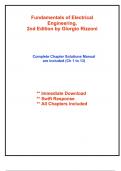Exam (elaborations)
Solutions for Fundamentals of Electrical Engineering, 2nd Edition Rizzoni (All Chapters included)
- Course
- Institution
Complete Solutions Manual for Fundamentals of Electrical Engineering, 2nd Edition by Giorgio Rizzoni ; ISBN13: 9780073380568.....(Full Chapters included Chapter 1 to 13)...Chapter 1 Fundamentals of Electric Circuits Chapter 2 Resistive Network Analysis Chapter 3 AC Network Analysis Chapter 4 Tra...
[Show more]



